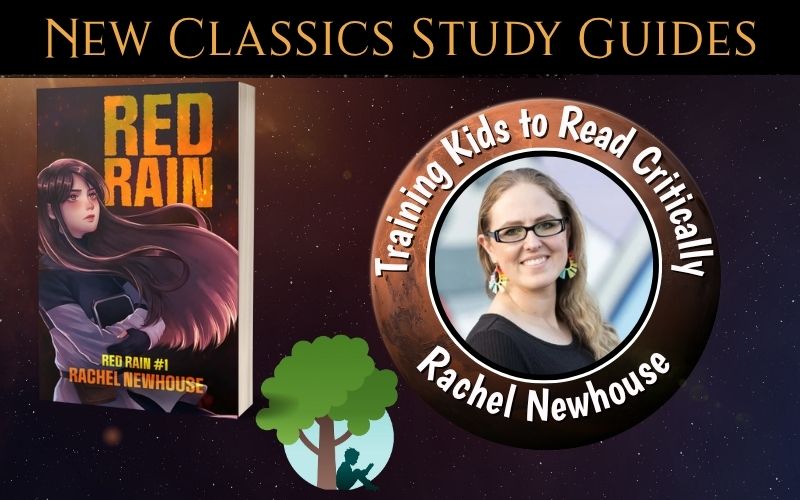Training Your Fiction Readers to Think Critically
Jul 22, 2025 6:01 pm
I love fiction—which probably comes as no surprise since I write it for a living! Every genre has something unique to offer. Dragons, spaceships, spies: I want it all. There’s no end to the fantastical worlds you can create with the written word, and I strongly believe reading fiction can be a catalyst for inspiring your homeschool student to dream and create.
But the sole purpose of fiction is not just to entertain. Fiction gains true power when we use it as a tool to analyze and examine the real world. Human nature, culture, and history are just some of the topics that can be explored through the allegory of fiction. As Christian parents, we also have the added responsibility of training our kids to look for biblical values and moral truth in the books they read. Even a secular piece of fiction can be an effective tool when we compare and contrast it with God’s Word.
For fiction to be edifying, however, we have to train our children to be critical readers instead of passive consumers. Thankfully, this is very easy to do, and with a bit of homework, it can count for school credit! Below are three simple ways you can train your kids to critically examine what they’re reading.
1. Ask your kids about what they’re reading. The first step in training critical readers is to turn books into discussion pieces. These don’t have to be deep questions. You can ask fun questions like:
- “What was your favorite character?”
- “Did you like how the book ended?”
- “Would you read more by this author? Why or why not?”
The purpose of this activity is to get your kids talking about what they’re reading—and encourage them to share with you. The more you engage with your kids, the more they’ll talk to you.
Need a place to start? All of the New Classics titles have free downloadable study guides, which contain great reading comprehension and discussion questions! The study guide for my book, Red Rain, includes several reading comprehension questions designed to help your student notice foreshadowing and literary patterns. Plus, there’s an answer key in case you don’t have time to read the book yourself!
2. Ask “What would you do?” The second step in training critical readers is to encourage students to put themselves in the story. Ask your reader what they would do if they were in the place of the character. I’d recommend starting with simple questions like:
- “Would you want to be a spy/dragon rider/amateur sleuth?”
- “Would you enjoy living in Narnia/Middle Earth/on Mars?”
Then move on to deeper questions like:
- “Do you think the character made the right choice?
- What would you do in this situation?
- Would you have responded differently?”
Encourage your reader to give a reason for their answer and ask them to find Bible verses that support their position. By doing this, you’re showing your child that they don’t have to agree with everything that’s on the page and teaching them to apply the lessons—good and bad—to their own life.
For middle grade and high school readers, you can easily turn questions like these into a short paper to count for school credit! The study guide for Red Rain includes multiple critical thinking questions that ask the reader to examine characters’ choices and find allegories in Scripture.
3. Ask “What if?” The final step in training critical readers is to show students that the story doesn’t end when the book is done. The real power of fiction comes when we allow it to feed our imagination so we can write our own stories. The best way to encourage readers to do this is to ask “What if?”
- “What do you think happened after the end of the book?”
- “What if this character had made a different choice? How would that have affected the story?”
- “What if the good guys lost? What do you think would have happened then?”
This way, students will not only think critically about how each character’s choices affected the book, but they’ll also realize that the best story is the one that hasn’t been written—and maybe they’ll be inspired to write something of their own.
For middle grade and high school students, this can become a creative writing exercise for English credit. The study guide for Red Rain has a step-by-step lesson for helping students invent their own dystopian story.
As you can see, training critical readers doesn’t have to be hard, for you or your student! I hope these questions have given you ideas for how to engage with your young reader—and that they’ll inspire a love of fiction that will last for years to come.
. . . is the author of the "Red Rain" dystopian sci-fi series. She is also a wife, secretary, and Sunday school teacher from Kansas City, Missouri. She loves all things sci-fi, dystopian, and kid lit. When Rachel is not writing, she’s cooking Asian food and growing chilis that are too spicy to eat. Grab your free copy of the study guide for Red Rain on the New Classics website.
---------------------
--------------------
You received this email because you signed up for our newsletter, entered a giveaway, or downloaded a freebie. Unsubscribe at any time.




